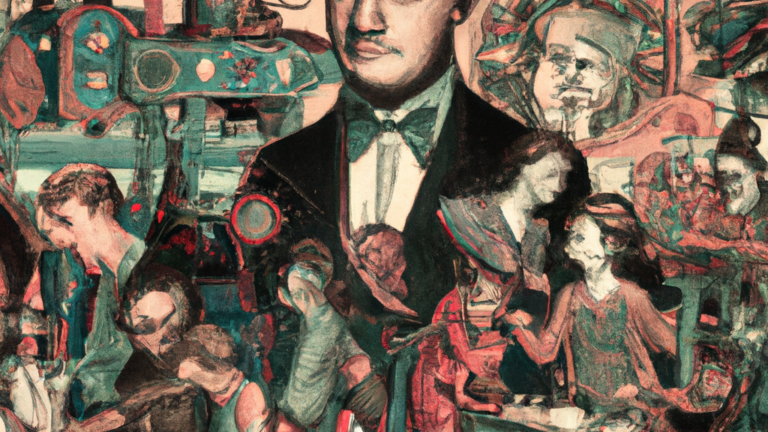As artificial intelligence (AI) continues to advance and integrate into various industries, concerns regarding job displacement and societal changes echo those of the early 20th century during the rise of industrial automation. This article examines the parallels and distinctions between AI technology adoption, with a focus on products like ChatGPT, and the technological transformations of the early 1900s. By understanding the similarities and differences, we can better prepare for the potential consequences and capitalize on the opportunities AI presents to us.
Historical Perspective: Early 20th Century Technological Advances
Taking a step back to examine historical technological advances offers valuable context for understanding the impact of AI and automation on today’s workforce. In the early 20th century, innovations such as assembly lines, mechanized production methods, and electricity revolutionized manufacturing and altered the employment landscape. The rise of industrial automation during this period had profound effects on productivity, production costs, and workforce demands. By exploring the past, we can gain a deeper appreciation of the present challenges and opportunities brought about by AI occurring today.
The Rise of Industrial Automation
The rise of industrial automation in the early 20th century marked a pivotal moment in the evolution of manufacturing. The introduction of assembly lines allowed for the mass production of goods, significantly increasing productivity and efficiency. Mechanized production methods along with electricity streamlined operations, leading to lower production costs and more competition. These advances also brought about shifts in workforce demands. Manual laborers saw their roles replaced by machines. Workers were now required to acquire new skills and adapt to an increasingly automated environment. This led to a reevaluation of the role of education in preparing workers for the job market. By reflecting on the challenges faced during this period of industrial transformation, we can draw valuable lessons in our approach to AI and automation in today’s workforce.
Job Displacement and Societal Changes
The advent of industrial automation brought about profound changes in the workforce. This led to job displacement and the need for workers to adapt to new, automated environments. Manual laborers faced challenges where their skills became obsolete or insufficient. Society was required to respond to these shifts and devise strategies to mitigate the negative impacts. The consequences of job displacement caused by automation prompted education reform with an increased focus on technical and vocational training. This also gave rise to labor unions to protect workers’ rights and interests. The widespread implementation of AI technologies may result in significant job displacement. Understanding these societal changes is essential in navigating the complexities of our AI-driven future.
AI Technology Adoption: ChatGPT and Beyond
The rapidly evolving landscape of artificial intelligence has brought forth groundbreaking technologies like ChatGPT, which has already in a very short time significantly influenced various aspects of modern society. From customer service to content creation, from data analysis to personalized experiences, AI technologies are reshaping the way we live, work, and communicate. The future is here now and AI adoption is likely to have a weighty impact on diverse industries considering all the advantages it offers, including increased efficiency, personalization, and scalability. By understanding AI’s role in modern society, we can better anticipate future developments and harness its full potential to drive innovation and growth.
AI’s Role in Modern Society
The integration of AI technologies, such as ChatGPT, into various aspects of daily life has transformed the way we interact, create, and analyze information. As AI continues to evolve at a very rapid pace. It is crucial to understand its role in modern society and the myriad benefits it promises. AI has permeated key areas like customer service, content creation, data analysis, to name just a few. By examining AI’s impact, the advantages of AI adoption, including increased efficiency, personalization, and scalability, we can better prepare to leverage its potential to enhance our lives and businesses. ChatGPT and similar AI technologies have already permeated many aspects of our daily lives, sometimes without us realizing it.
The AI Job Displacement Debate
As AI becomes more pervasive, concerns about job displacement will intensify. The impact of AI on the workforce will mirror early 20th-century concerns, presenting potential consequences such as the replacement of repetitive manual tasks, an increased demand for new skills and expertise, and a shift towards more creative and strategic roles. By understanding these implications now, we can better anticipate effects on the job market and the roles workers will occupy in the future brought about by AI and the resulting transformation.
The AI job displacement debate is an ongoing and complex discussion centered around the impact of artificial intelligence on the workforce, both in terms of potential job losses and the creation of new jobs. As AI technologies become increasingly sophisticated, there will be growing concern that many jobs currently performed by humans will be replaced by machines, leading to widespread unemployment and social unrest.
Proponents of AI argue that its adoption will ultimately lead to the creation of new jobs that have not yet been envisioned, much like how the Industrial Revolution gave rise to new professions. They emphasize that AI can be used to augment human labor, increasing productivity and efficiency while allowing workers to focus on more strategic and creative tasks. Furthermore, proponents point out that AI has the potential to improve the overall quality of life by automating mundane and repetitive tasks, freeing up time for more meaningful pursuits.
On the other hand, critics of AI assert that the rate of job displacement may outpace the creation of new jobs, leaving many workers unable to adapt and find new employment. They argue that the shift in workforce demands will disproportionately affect low-skilled workers and exacerbate existing income inequality. Critics also emphasize the importance of implementing social safety nets, such as universal basic income, to support those who may be negatively affected by the rapid adoption of AI technologies.
To address the AI job displacement debate, a multifaceted approach is necessary. This includes investing in education and retraining programs to equip workers with the skills needed to succeed in an AI-driven economy, fostering collaboration between industry, academia, and government to create a supportive ecosystem and implementing forward-thinking policies that protect workers while encouraging innovation.
As the debate continues, it is essential for all stakeholders to engage in open and informed discussions about the challenges and opportunities presented by AI. By fostering a proactive approach to workforce development, regulation, and ethics, society can better navigate the complexities of AI adoption and ensure a more inclusive and resilient future.
Comparing AI Adoption to Early 20th Century Technological Advances
In the pursuit of understanding the transformative power of artificial intelligence, it is essential to draw comparisons to historical technological advancements and examine how society can best prepare for AI’s impact on the workforce. This analysis requires a comprehensive examination of the similarities and differences between AI adoption and early 20th-century technological advances, as well as strategies to ensure a smooth transition for society.
Similarities
Drawing parallels between AI adoption and early 20th-century technological advances can provide valuable insights into the potential implications of AI on the workforce and society as a whole. By examining the similarities between these two transformative periods, we can learn from historical experiences and better anticipate the challenges and opportunities that lie ahead. There are commonalities that both eras share, such as rapid technological progress, disruption of traditional industries, increased productivity and efficiency, job displacement, and the need for workforce reskilling. Understanding these shared aspects allows us to contextualize AI’s impact and inform our approach to addressing its potential consequences.
Differences
While the similarities between AI adoption and early 20th-century technological transformations offer valuable insights, it is equally important to acknowledge the key differences that set AI apart from previous innovations. Understanding these distinctions allows us to better comprehend the unique challenges and opportunities that AI presents. The broader impact of AI on various industries has accelerated the rate of change with AI augmenting human capabilities rather than simply displacing workers. These distinct aspects of AI adoption will have far-reaching effects on the workforce and the wider society.
Preparing for AI’s Impact on Society
As we navigate the transformative landscape of artificial intelligence, it is imperative for society to proactively address the challenges and opportunities AI presents. Preparing for AI’s impact on the workforce involves a two-pronged approach: fostering an environment that supports education and reskilling, and adapting to the rapid pace of AI’s evolution. By cultivating a holistic strategy that encompasses workforce development, regulatory frameworks, and embracing the potential of AI as an augmentative tool, we can ensure a more resilient and inclusive future for all members of society.
To minimize the negative effects of AI on the workforce, it is crucial to invest in education and workforce training, develop programs for lifelong learning, and foster collaboration between industry, academia, and government. Adapting to AI’s rapid development will require agility and flexibility in businesses and individuals as well as a proactive approach to regulation and ethics. It will also require us to embrace AI as a tool for human augmentation and collaboration.
As we consider the many facets of AI’s rapid evolution and its impact on society, it is essential to address the questions and concerns that arise in this ever-changing landscape. By engaging in open dialogue and sharing knowledge, we can better equip ourselves to navigate the challenges and opportunities that AI presents.
Questions and Answers to Ponder about AI Adoption
How is AI adoption like early 20th-century technological advances?
AI adoption is like early 20th-century technological advances in several ways, such as rapid technological progress, disruption of traditional industries, increased productivity and efficiency, and job displacement. Both periods witnessed transformative innovations that reshaped the workforce, necessitating reskilling and adaptation to new technologies.
What are the key differences between AI adoption and early 20th-century technology transformations?
The key differences between AI adoption and early 20th-century technology transformations include AI’s broader reach, impacting a wider range of industries; the faster pace of change, leading to quicker adoption and adaptation; and a greater potential for augmentation, rather than pure displacement of human workers, as AI can enhance human capabilities and foster collaboration.
How can society prepare for the potential consequences of AI on the workforce?
Society can prepare for the potential consequences of AI on the workforce by investing in education and workforce training, developing programs for lifelong learning, and fostering collaboration between industry, academia, and government. Additionally, promoting flexibility and agility for businesses and individuals, taking a proactive approach to regulation and ethics, and embracing AI as tools for human augmentation and collaboration will also help mitigate the negative effects and capitalize on the opportunities AI presents.
In Conclusion
The adoption of AI technology, including products like ChatGPT, shares similarities with early 20th-century technological advances, such as increased productivity, disruption of traditional industries, and job displacement. However, there are notable differences, including AI’s broader reach, faster rate of adoption leading to a swifter pace of change, and the potential for human augmentation. By recognizing these parallels and distinctions, society can better prepare for AI’s impact and capitalize on the opportunities it presents.
#AIAdoption #JobDisplacement #FutureOfWork
About the Author
Stephen Howell is a multifaceted expert with a wealth of experience in technology, business management, and development. He is the innovative mind behind the cutting-edge AI powered Kognetiks Chatbot for WordPress plugin. Utilizing the robust capabilities of OpenAI’s API, this conversational chatbot can dramatically enhance your website’s user engagement. Visit Kognetiks Chatbot for WordPress to explore how to elevate your visitors’ experience, and stay connected with his latest advancements and offerings in the WordPress community.



Leave a Reply
You must be logged in to post a comment.